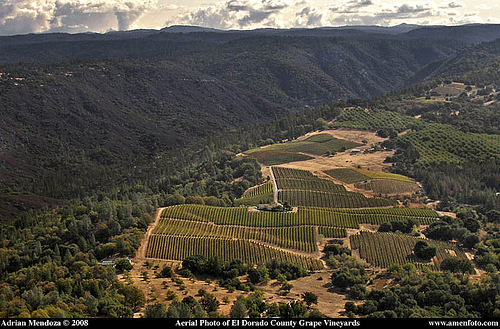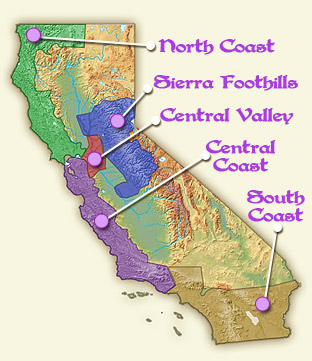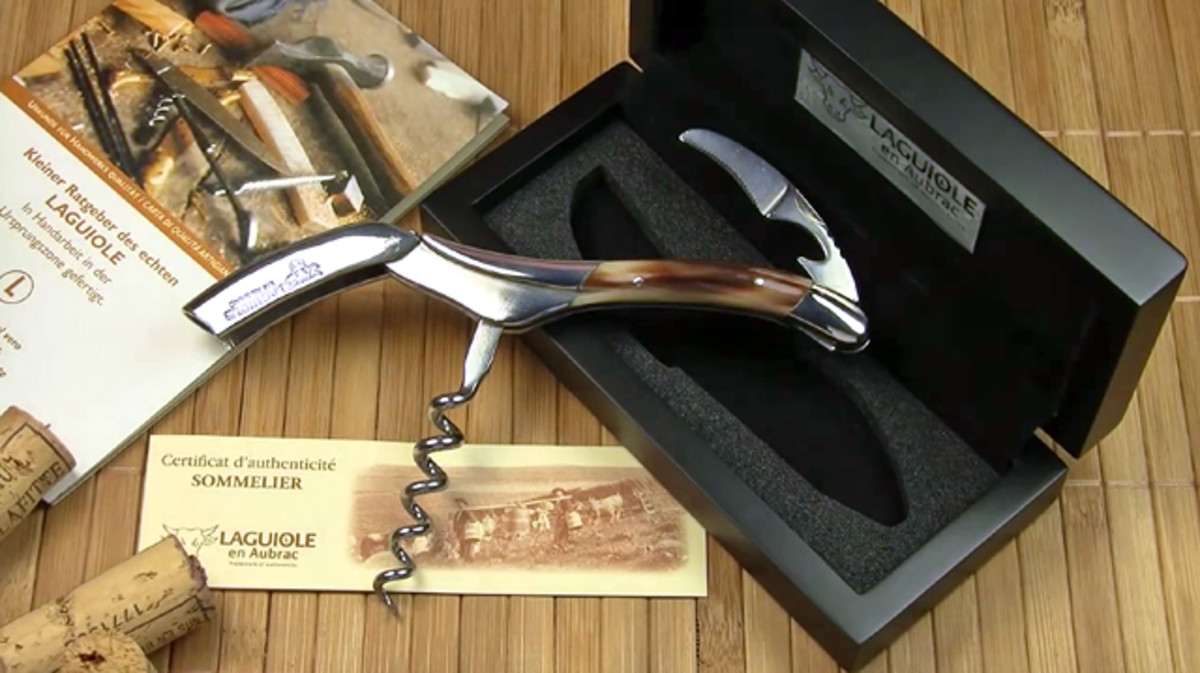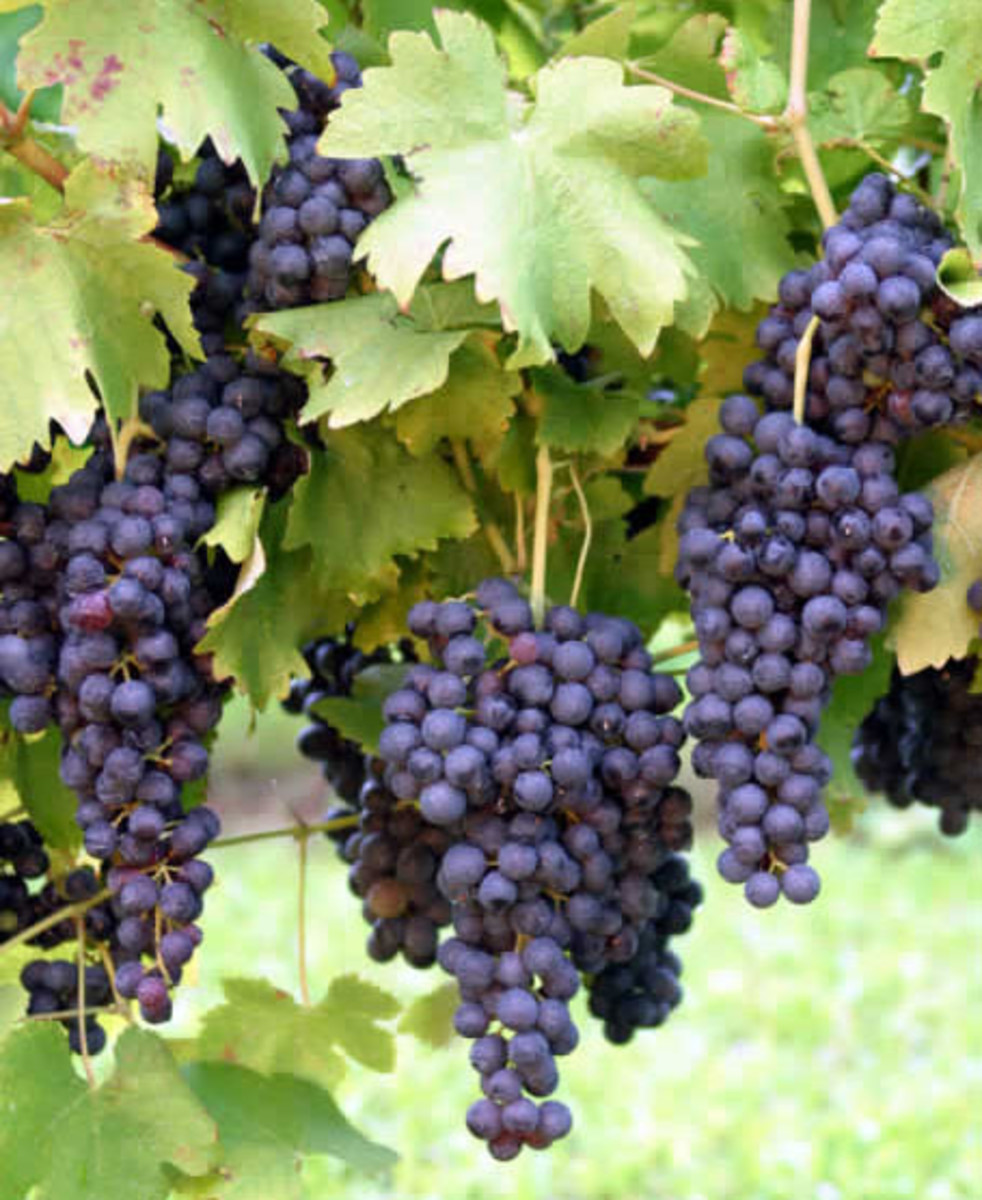The Sierra Foothills Wine Region in California - Gold Country and the Gold Rush
The Sierra Foothills region is located in Northern California, just East of Sacramento. In the mid 1800’s, people from all over the world traveled to this area of California in search of a better life. More importantly, they were after gold. This event became known as the California Gold Rush. Some immigrants even planted grape vines that they brought with them overseas from Europe. Ever since this time, the Sierra Foothills region has been known as “Gold Country”. The influence of Sierra Foothills on the wine-making industry of California is immeasurable. It has had countless effects on not only the economy of Sierra Foothills itself, but the entire state of California’s economy as well.
In order to understand the history of winemaking in the Sierra Foothills, it is necessary to first examine the economics at work during the Gold Rush. Continuous mining during the gold rush filled the rivers with trash. Sierra Foothill’s economy at this time revolved around the transport of goods to the main water ports. All of the miners hoped to strike it rich and they searched streams throughout the region for gold: “These miners had an incessant thirst for alcohol. This demand led to the birth of the Sierra Foothills Wine Country” (Nelson). The early wine business in the Sierra Foothills was booming simply to meet the demands of the gold miners. The effects of these miners on this wine region are still noticeable today. The paths of rivers were changed by wooden planks used to search the river for gold. They also began to dig deep into the earth: “To this day, there are man-made canyons that are hundreds of feet deep in the Sierra Foothills from this process. Debris washed downstream to the Delta and caused massive flooding and devastation at the time” (Nelson). Most of the trees in this area were eliminated to build flumes for the rivers. Now, it is rare to find a tree in this area older than 150 years.
Sierra Foothills Region

Something was about to happen, however, that would change wine-history in Sierra Foothills forever: prohibition. After prohibition was enacted, the only winery that was able to maintain operation was Fossati-Lombardo: “the Fossati-Lombardo Winery retained its bond to produce wine for local churches. The wine industry in the Sierra Foothills fell even further into oblivion in the decades immediately following the repeal of Prohibition” (Nelson). Interestingly enough, the first post-prohibition winery in the Sierra Foothills was created in 1973. The region has shown a steady growth since then. The lasting effects of prohibition are easily seen even decades after it ended.
The wine making aspect of the Sierra Foothills region really began with these immigrants: “Along with picks, shovels, and rockers, the people who came to California for gold also brought grape vines, and planted vineyards near the gold fields” (Stone). Wine making is an essential part of the history of the state of California. In fact, wine-making was only done in the Sierra Foothills region up until the late 19th century, when the railroad and irrigation were invented (Sullivan1 328). After the Gold Rush slowed down, “descriptions of the Gold Country towns in the 1860’s almost always included the splendor of the vines” (Sullivan1 329). Most of the early wine produced in the Sierra Foothills was made with mission grapes.
Mission grapes are the oldest viniferous grapes that are cultivated in the United States. For well over a century, “the mission grape defined California viticulture, but it barely exists there as a variety today” (Ramey). As the immigrant wine makers began taking over the business in California, more of the mission grapes were being planted. Because of this, the well-liked variety status of the grapes declined, and “since 1990, less than two hundred acres have been planted statewide to Mission grapes” (Ramey). The reason why mission grapes were popular in the early wine days of the Sierra Foothills can be easily identified by examining the vines themselves. Mission vines are strong, vigorous, and will yield a large amount of grapes. Because of the mission vine’s large trunk and strong cane, “the fruit clusters grow large and are loosely filled, so that ripe fruit can hang for a relatively long time, developing high sugar content while resisting mold or rot” (Ramey). Even though mission is a dark skinned grape, it makes a brownish white wine, and a light red wine. The only Californian wineries still using the mission grape are located in Gold Country. A few examples of wineries in this region still using mission grapes are: Nina Gables, Story, and Domaine de la Terre Rouge. The most interesting part of the mission grape, however, is its history. Allegedly, Jesuit Missionaries moved the original vines from Spain to Mexico in the 1500’s. It was cultivated there for over a century before it began to move North, and “more than a century later, Franciscan monk Junipero Serra first planted the Mission variety in California, at Mission San Diego, in 1769” (Ramey). It is still being grown there today, although, not nearly as much.
Along with the mission grape, another different variety was brought to California during the Gold Rush time period as well. It’s origins have been the subject of much debate for years, although now most agree that “the roots of Zinfandel (as well as Primitivo) are most likely in the Dalmatian province of Croatia (in the former Yugoslavia) where DNA matches have been made with a variety locally known by the name of Crljenak Kasteljanski (also Pribidrag or Tribidrag)” (Zinfandel). The wine made from this grape became known as Zinfandel. Because it thrived so well in the regions climate and soil, it became popular rather quickly. Its disease-resistant vine serves as an explanation for the fact that some 100 year old Zinfandel vines are still producing grapes. Today, “Zinfandel is the third leading wine-grape variety in California, with nearly 49,891 acres planted, according to the 2009 California Grape Acreage Report” (California Zinfandel). The most famous wine made from the Zinfandel grapes is White Zinfandel, “which holds a 10% share of the total 188 million cases of California table wine volume shipped to the U.S.” (California Zinfandel). Almost all of the wineries in this area produce a type of Zinfandel: “they tend to aim at the high-end premium product, whose labels often bare the name of local AVAs such as Shenandoah Valley, Fiddletown, and El Dorado” (Sullivan2 181). The vine yields are similar to other major wine producing regions of California such as Sonoma and Naple, however, the grape prices are much different. The wineries in the Sierra Foothills region “pay only about half the price for Zinfandel grapes that North coast producers had to meet in 2001. In that year, the highest price for any lot of Foothill’s Zinfandel (15.6 tons at $2000) was less than the average price paid in Sonoma for that variety” (Sullivan2 181). Clearly, Zinfandel has had much success, not only in the Sierra Foothills, but in all California. The amount of success is easily shown with some acreage statistics: “There were about 400 acres of Zinfandel in 1970, rising to 1,275 acres in 1980. In 2002 there was well over 2000 acres of Zinfandel, accounting for about half of the wine-grape acreage for the region” (Sullivan2 122). Coming in second place with 500 acres was Cabernet Sauvignon.
Zinfandel, the vine itself, has a hardy nature. Since the vines are great adaptors to different climates and soils, they are usually strong and productive. The grape clusters of Zinfandel are full and compact; however, the berry-stems are usually short: “These factors make Zinfandel somewhat susceptible to bunch rot and some types of mildew” (7). Good water management is extremely important when dealing with Zinfandel vines. Enthusiasts say that at its best, Zinfandel has a fruity and “jammy” quality. Certain foods go well with Zinfandel as well: “When paired with outdoor-grilled steaks or chops or meat that has been stewed with or stuffed with fruit, Zinfandel becomes a prime motivation for people to become wine-lovers” (LaMar). Also, it is important to make note of the fact that Zinfandel becomes more mello with age, and the heavier it is, the better it will taste with age.
California Wine Map

What exactly makes the wine produced in the Sierra Foothills region have such a robust taste? Well, it’s the soil, of course. At the 2000 foot elevation, most of the vineyards “are set in a soil made of decomposed granite, a product of erosion from the Sierra Nevada range” (Stone). This specific type of soil is most commonly found in Amador County, Calaveras County, and El Dorado County. At the 3000 feet elevation level in El Dorado County, the soil is composed of volcanic-rock from a volcanic eruption that occurred in the area more than ten million years ago. There is a winery located in this area that takes its name directly from this event. It is called the Lava Cap Winery, and it has more than 130 acres of vineyard. Both the granite and volcanic-rock soils have great drainage, as well as low nutrients, which sends the vines searching in the ground for more water. Some of these Zinfandel vineyards are even dry-farmed: “These vines bask in the intense summer sunshine, and produce skins with a deep blue/black color. Stressed vines produce richer, more deeply flavored Zinfandels, Cabernets, and Syrahs” (Stone). Every grape-grower knows that the harder the roots have to work at getting their fill of water and nutrients, the better the wine will turn out in the end.
The BATF created the Sierra Foothills viticulture area in 1987, and “it encompasses about 4200 square miles, running about 170 miles from Yuba to Mariposa counties. Today there are about 3900 acres of vines in the foothills area, almost 90% in red varieties” (Zinfandel1 333 ). As with any wine-making region, the climate of the Sierra Foothills plays a large role in the wine that is produced. The amount of rain in California usually decreases from North to South, and from West to East. Since high elevation means more rainfall, the Sierra Foothills region receives more rain than the Central Valley. Also, the Sierra Foothills has warm days and cool nights, the perfect climate for growing Zinfandel.
Many award winning wines were grown in the Sierra Foothills region. The area that came up the most through research of this region was El Dorado Wine Country. They are known for creating colorfully flavored, delicious wines at high elevations. Every Mother’s Day weekend, El Dorado hosts an event called the “Art and Wine Affaire”. This year, twenty local El Dorado wineries will be attending the event, offering wine tasting. Also, over 150 artists will be displaying their work. The Sierra Foothills offers something for everyone. Not only are there over one hundred wineries with their own private tasting rooms, there is a large selection of wine ranging from award winning Zinfandels to high quality variations of other wine such as: Syrah, Cabernet Sauvignon, Sangiovese, and Sauvignon Blanc. Other various events centering around wine are held everywhere throughout the region at all times of the year. Local wine-makers offer special promotions, free wine, and barrel tasting. Another interesting event of the Sierra Foothills region is the Annual Calaveras Grape Stomp. Once a year, the Calaveras Wine Grape Alliance puts on a fair in the city park. Competing groups of people stomp on grapes, and the team that makes the most grape-juice wins. Awards are then presented to the best stompers and of course, the best costume.
The Sierra Foothills have played an influential role in the development of the state of California. Although some may consider this region sub-par, it was a major contributor to the growth of the population, as well as the financial state of California. With great wine varietals such as Mission and Zinfandel, the Sierra Foothills region has much to offer a wine-maker. The climate and terroir is suitable for growing excellent grapes. Without historical influences such as the Gold Rush, and technological advances in transportation as well as irrigation, Californian wine-making would be completely different today. The flower that is the California wine industry would not have been able to blossom if it weren’t for the Sierra Foothills.
Works Cited
"California Zinfandel." Wine Institute Press Room (2010): n. pag. Web. 19 Apr 2011. <http://www.wineinstitute.org/resources/winefactsheets/article99>.
LaMar, Jim. "Zinfandel / Primitivo." Professional Friends of Wine. Jim LaMar, 9 Dec 2010. Web. 19 Apr 2011. <http://www.winepros.org/wine101/grape_profiles/zinfandel.htm>.
Nelson, Donald. "The History of Wine Country in the Sierra Foothills and Delta." Sierra Wineries (2008): n. pag. Web. 19 Apr 2011. <http://www.sierrawineries.com/history.html>.
Ramey, Tim. "Mission." Professional Friends of Wine. N.p., 26 Oct 2009. Web. 19 Apr 2011. <http://www.foothillwine.com/wineries.html>.
Stone, Don. "The Foothill Wine Region." Foothill Wine. Onroute Communications LLC, n.d. Web. 19 Apr 2011. <http://www.foothillwine.com/wineries.html>.
Sullivan, Charles. Companion to California Wine: an Encyclopedia of Wine and Winemaking from the Mission Period to the Present. Berkeley University of California Press, 1998. Print.
Sullivan, Charles. Zinfandel: A History of a Grape and its Wine. Berkeley University of California Press, 2003. Print.
"Zinfandel." Appellation America. Appellation America Inc., n.d. Web. 19 Apr 2011. <http://wine.appellationamerica.com/grape-varietal/Zinfandel.html>.
More Hubs by LeisureLife:
- The Lapis Niger - Mystery in the Forum Romanum - Ancient Mythology in Rome
At the center of the city of Rome lies the Forum Romanum, a small, rectangular plaza surrounded by the ruins of ancient government buildings... - Language in the Classroom
The article Why Do They Get It When I Say Gingivitis But Not When I Say Gum Swelling? explores how a students native language affects their understanding of Anglo-Saxon and Greco-Latinate... - The Perfect Tree (A Christmas Essay) Tradition
It is cold outside. A winter coat, snow pants, and gloves are not enough to keep me warm. I dont care. This is the day Ive been waiting for since Thanksgiving. As December 25 draws near,... - Effects the Automobile has on Society and Changes in Cars Made by Generation
The invention of the automobile has brought more positive and negative effects than any other invention throughout transportation history. As the most widely accepted method of transportation, cars have... - The Baroque Period of Music 1600-1750 European Classical Era Time Period
When considering the many periods of music which have existed throughout history, it is obvious that many periods have made long lasting contributions to music overall. However, the Baroque period is the...





